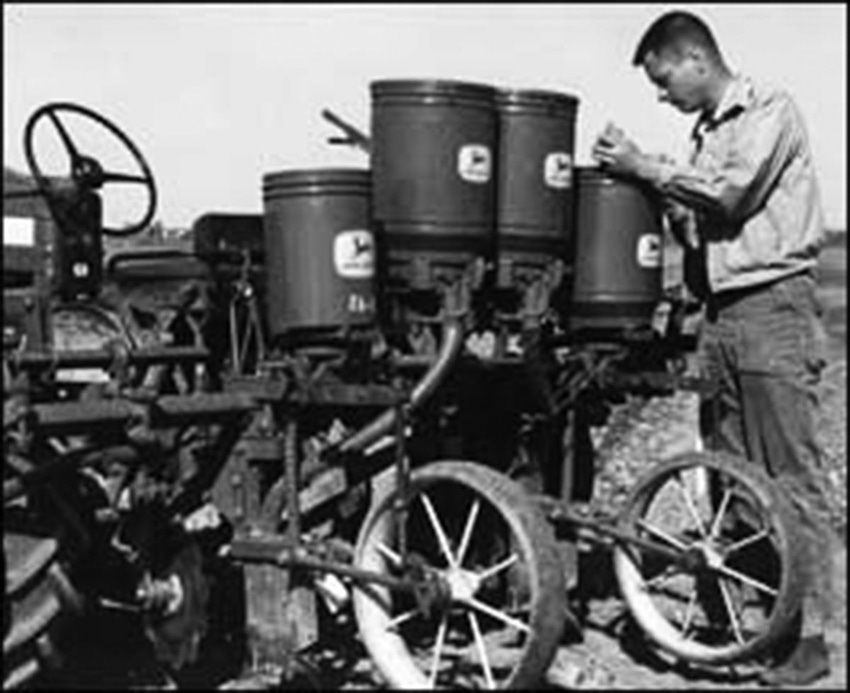September 11, 2018

Delta Farm Press has never considered itself to be a no-till magazine — its editors always sought to broaden its coverage to all facets of Mid-South agriculture. Nevertheless, the publication and no-till farming have been intertwined over the decades.
Edward Faulkner’s The Plowman’s Folly, one of the first books to espouse the idea that farmers didn’t have to till the soil to grow crops, was published in 1943, the same year the Clarksdale, Miss., Daily Press began printing Delta Farm Press as an insert.
Dr. John Bradley, Extension agent in Lake County in northwest Tennessee, wrote articles for Delta Farm Press in the 1970s and early 1980s before becoming director of the Milan, Tenn., No-Till Research Station and the Milan No-Till Field Day, which attracted thousands of farmers in the 1980s and 1990s.
In the 1990s, Delta Farm Press editors wrote two books on no-till farming — one sponsored by Monsanto, the other by American Cyanamid — to help farmers better understand the basics and the benefits of the practice.
Bradley, who later became the southern U.S. conservation tillage specialist for Monsanto from 1997 to 2003, continues to consult with growers about converting to conservation tillage in the U.S. and in countries like Russia, Indonesia, Brazil, Argentina, Australia, and Bolivia.
Although he’s convinced of the benefits of the practice he’s preached for more than 40 years, Bradley admits no-till or conservation tillage hasn’t always been an easy sell.
“Tom McCutchen (the first superintendent of the Milan Research Station) didn’t have the blessing of the University of Tennessee when he began his no-till research in the 1960s. They told him not to do it, that they weren’t going to have any part of it.
“After they told him that, he moved the no-till work to the back of the experiment station,” says Bradley, who chronicled the history of no-till in a presentation for the Tennessee Agricultural Production Association’s annual Winter Agronomic Workshop at Jackson. “But he kept the researchers interested in it.”
EXTENSIVE EROSION LOSSES
At the time, Tennessee, and particularly west Tennessee, led the nation in soil losses from erosion. Not only was the land hilly, except for the sliver that lay alongside the Mississippi River, but the region was the location for the majority of the state’s row crop acres.
“We had cotton fields that were losing up to 80 tons of soil per acre per year,” says Bradley. “Farmers were literally having to take bulldozers to push in gullies so they could get pickers across the field.”
That was the environment scientists like McCutchen; Glover Triplett, who worked at Ohio State University; and Lloyd Murdock and Jim Martin at the University of Kentucky, worked in when they were doing their initial research on no-till and conservation tillage.
McCutchen helped build a team of researchers, including weed scientist Bob Hayes, who later became director of the West Tennessee Research and Extension Center at Jackson; longtime soil scientist Don Tyler, who recently passed away; plant pathologist Albert Chambers; soil scientist Don Howard; pasture renovation specialist Joe Burns; cotton specialist Phil Hoskinson; cotton entomologist Gary Lentz; and agricultural engineers Curtis Shelton and Will Hart.
“They called it TNT for the Tennessee No-Till Team Approach,” says Bradley, who worked with McCutchen while he was an Extension agent in Tiptonville, and with scientists from the University of Kentucky while Bradley worked on the Reelfoot Lake project. “If you’ll notice all of the different disciplines are represented. Tom was the leader and the inspiration, but it really was a team approach.”
NOT A NEW CONCEPT
Glover Triplett, a Mississippi native who received his Ph.D. at Michigan State University, helped establish some of the first no-till research plots in the U.S. at Ohio State University. More than half a century later, the no-till plots, which long ago were named the Triplett-Van Doren No-Tillage Experimental Plots, are still going. (David Van Doren was a soil physicist at Ohio State who worked with Triplett.)
In a 2014 interview with Delta Farm Press, Triplett said the no-till concept wasn’t new even in 1963; that Dr. Louis Wise, a forage agronomist at Mississippi State University, was planting wheat, rye, and winter oats directly into pastures when Triplett was an undergraduate there. (Triplett retired from Ohio State in 1982 and returned to Mississippi, beginning a second career as a research professor of agronomy with the Mississippi Agricultural and Forestry Experiment Station.)
At the time Triplett was working in Ohio, researchers in western Kentucky were trying to find ways to make no-till work in the South. “The first documented on-farm demonstration of no-till was done by Shirley Phillips, Extension agent, and Harry Young in Christian County in western Kentucky,” Bradley says. “They have a plaque commemorating more than 44 years of continuous no-till on that farm.
“One of the reasons no-till started in western Kentucky was to try to stop the erosion of soils coming out of the old Land Bank program in the 1950s. Farmers were growing soybeans in wide rows and the land just washed away. They began with a mule-drawn planter that was modified for no-till and pulled by tractors. The only herbicides they had to work with in no-till then were 2,4-D, atrazine, and paraquat.”
EARLY DRAWBACKS
The lack of herbicides and equipment adapted for no-till were among the early drawbacks for farmers and researchers who wanted to experiment with the concept of planting without tillage, Bradley says.
“We didn’t have the equipment, and we had to sell equipment companies on the idea of what we needed. And we worked with growers — I couldn’t count how many times I went out and helped them with setting planters and coulters on no-till planters.”
Interest in no-till began to expand when burndown herbicides such as glyphosate, glufosinate, and dicamba were registered for use in row crops, and new planters and spray equipment came on the market.
The advent of Roundup Ready crops in 1996 brought even more interest in reduced tillage. It also took Bradley from the university system to private industry in 1997, when he became Monsanto’s no-till specialist for the 17 cotton states.
“That’s when Roundup Ready cotton came out, and they were interested in increasing the sales of Roundup. And the best way to do that was to take advantage of burndown, and then to take advantage of in-crop applications of Roundup. But that also helped with the wider adoption of no-till.”
The first Milan No-Till Field Day, held in 1981, was attended by 500 farmers. In the following years, attendance topped 10,000, as farmers from all over the world journeyed to west Tennessee to learn about no-till. The field day is held in alternate years now — 2018 will be one of them — but it continues to attract good crowds.
The growth in the popularity of the field day mirrored the adoption of no-till as farmers learned about the cost savings and soil benefits of different forms of no-tillage. Not everyone was willing to completely do away with tillage, but many found they could reduce their costs by reducing the number of trips they made across their fields.
And it reduced erosion. At one time in the 1970s, Tennessee’s soil loss was averaging 14.5 tons per acre annually across the entire state. After no-till began to take hold, the annual loss dropped below 3 tons per acre.
A WORK IN PROGRESS
Even with the wider adoption, conservation tillage is still a work in progress, says Glover Triplett, who at near-90 continues research at Mississippi State University. Each year more insight is added to making the system more effective and efficient, he says.
When he was at Ohio State, he encountered different weeds — quackgrass, timothy, Kentucky bluegrass, orchardgrass, and smooth bromegrass — than he was accustomed to seeing in Mississippi.
“Growers were using a rotation of two or three years of alfalfa, wheat, and grasses, after which they’d plow and plant corn,” he said in the 2014 Delta Farm Press interview. “We could use 2,4-D to kill the alfalfa, spray atrazine, and get the land clean to plant corn. On those soils, which had low clay content and didn’t crack when dry, no-till did as well or better than conventional tillage.
No planters were available then that could plant corn in undisturbed sod, but Triplett remembered some grassland drill openers that Dr. Wise had used in his forage studies at Mississippi State and obtained some from John Deere for the early work in Ohio.
“After we’d done some work with it and demonstrated the feasibility of no-till, we published an article about it,” Triplett said. “People would come and look at our plots and shake their heads and say ‘Well, you might do this for three, four or five years, but sooner or later you’re going to have to plow.’
“At the 40-year anniversary of our study, there was a field day in honor of the program, and I went back to participate. Remembering those, who all those years ago, has said ‘Sooner or later you’re going to have to plow,’ I wondered just how much longer it would be.”
About the Author(s)
You May Also Like






